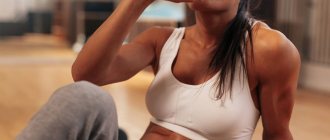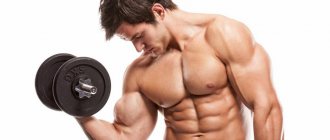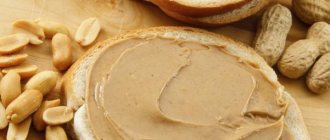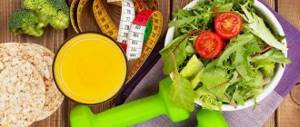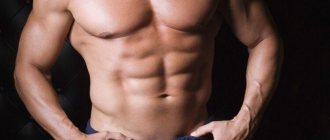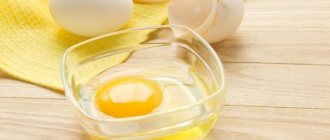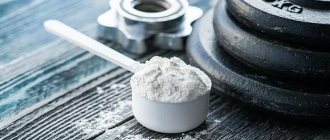Coffee when drying the body.
Not so long ago, the phrase “drying the body” was understood only by bodybuilders, since “building” a beautiful body was part of their professional duties. Now that the term has become widespread, and the method of losing weight has gained extreme popularity, a diet that ensures getting rid of fat deposits and an impeccable sculpted figure has become necessary among representatives of both sexes and different ages.
Two questions that worry everyone who is seriously involved in drying: 1. How to balance the diet in order to achieve the desired result? 2. Is it possible to drink coffee while dieting?
The essence of the drying method
The main goal of those who are engaged in drying the body is to use up fat deposits without harming muscle mass. The topic is fertile, a huge number of professionals have appeared on it, and their advice is sometimes radically different. There are advisors who specialize only in drinking during the drying period.
Drinking, liquid, drying - a certain illogical series develops. Still, you need to drink while drying – including coffee.
Drying is a difficult process that requires caution, it puts the body in a state of shock, but this is not exhausting yourself by starvation - you should receive enough protein and water during the drying period.
A light protein-vegetable breakfast, ending with coffee, and coffee with biscuits are included in the list of impeccable products created to create an athletic body.
But it is definitely recommended to drink coffee bitterly, without adding sugar or a sweetener. This way you can get maximum benefits from the drink.
In addition, coffee has proven itself to be a good diuretic, which is very valuable during the drying period: the body receives a sufficient amount of water, and it does not stay in it for longer than a certain time. There is a natural circulation of water in the body - it is not deprived of it and cannot suffer from a lack, but, at the same time, there is no excess water in it.
On buckwheat without salt
Salting buckwheat prepared for the diet is strictly not recommended. It would seem, why is salt harmful, since it has a minimum of calories? The fact is that the essence of the buckwheat diet is cleansing. And salt, acting as a taste enhancer, can slow down this process, as it retains water in the body.
Important. With regular physical activity, even light exercises at home, salt is acceptable. Its deficiency can lead to decreased blood pressure and cause chronic fatigue.
Drying at home
Drying the body of professional athletes and those who like to go to fitness are completely different processes. In the first case, everything happens under the strict control of a trainer and is accompanied by strong physical exertion.
In the second place, it’s enough just to eat right and (an indispensable condition!) to reduce the amount of goods that retain fluid in the body.
Drinking coffee - natural, high-quality - helps remove excess water, and you must drink it under the following conditions: only in the morning and less than 2 cups.
Coffee when drying the body.
Previously, only bodybuilders were engaged in drying the body before competitions, where it is necessary to show very well-developed muscles without excess fat and water. Now it is used by people who are interested in sports, bodybuilding, wrestling (when necessary, while maintaining strength, reduce weight and fight in a lighter category), as well as models before filming. Drying the body usually occurs on a special diet, and many are worried: can coffee be used when drying the body, will it harm, and if it can help, then how?
The essence of drying the body and the effects of coffee on the body
Cutting involves a low-carb diet with limited water and food while maintaining exercise. The body needs energy, and it gains it from its own fat deposits. Athletes reduce the proportion of carbohydrates, in recent days consuming only the minimum, less than 2 g of carbohydrates per kilogram of body, and often up to 1 gram. The body intensively consumes fat reserves. A bodybuilder drinks a lot of water all week, and during the day he practically stops drinking it. The body, accustomed to the influx of water, intensively continues to remove it, so there is practically no water left on the body. Without water, the body seems to dry out, the muscles are drawn very accurately, the “cubes” and the whole relief are visible.
Coffee is great for removing water from the body, and all athletes usually drink it while cutting.
The benefits of coffee for drying the body
The beneficial characteristics of coffee are appreciated by many athletes; it is included in examples of drying menus; it is eaten by models and bodybuilders. Trainers can encourage caffeine consumption even for those who do not normally drink caffeine.
- Coffee is a good diuretic that allows you to more actively remove water. That’s why athletes include it in their diet during the drying process. The body receives a lot of water, usually about 2-3 liters per day, so it does not feel dehydrated, but at the same time, water does not accumulate. This is the natural circulation of water - the body is not deprived of water, but at the same time the weight is miniaturized, water is not retained in the tissues.
- Protein foods often cause constipation. A cup of coffee will help clear your intestinal tract on the day you weigh yourself. But do not drink it on the day of a competition or show - it can have a harsh effect on an exhausted body, causing diarrhea. Watch your condition, and do not experiment on your important day.
- During a low-carbohydrate diet, the body feels a lack of energy, lethargy, drowsiness, and weakness are observed. And you need to continue training to get rid of the remaining fat deposits. And caffeine helps a lot with this, working as a natural catalyst. It charges you with energy, gives you more strength for training, helps you work to the maximum in order to lose weight very quickly.
A cup of coffee half an hour before training invigorates you, even if it seems that you have no strength left to exercise. You can exercise more actively and more productively, with better results, and lose fat faster.
Can coffee harm your body when drying?
Maybe, but only if you drink a lot of it. Fighting lethargy requires high-quality rest and plenty of sleep. You cannot exist only on caffeine, in such a state of a weakened body that does not receive enough energy, even the usual number of cups of coffee, if you drink a lot of it, can lead to heart pain, neuralgia, etc.
Consider the total amount of caffeine that enters the body, including with green or black tea, as well as with synthetic products, if you take them.
Buckwheat on drying
In the Weight Correction , to the question Has anyone been cutting? (such a diet) asked by the author Dasha Mi the best answer is Summer is already on the doorstep, you already want to go to the beach, but your figure is still so far from perfect... What to do? We need some effective and quick way to lose weight. And at the same time, you don’t want to torture your own body with unimaginable stress or extreme foods. So, we want to lose weight while remaining vigorous and cheerful. That is, we need a diet that will help you effectively lose weight and not starve at the same time. Such a diet exists - buckwheat. It is designed for one week, but the most persistent ladies can withstand up to two weeks. This is exactly what we will talk about at MirSovetov. Products for the buckwheat diet The essence is simple: take one glass of uncrushed buckwheat, pour two glasses of boiling water and leave to steep overnight. We eat only buckwheat rum, washing it down with 1% kefir. You cannot add salt, sweeten or add butter to buckwheat. You can eat “as much as you like” at one time - unsalted buckwheat has such a specific taste that you are unlikely to eat more than 10 spoons at a time. Kefir should be fresh and not sweet. On the first day of the buckwheat diet, one glass of brewed buckwheat (that is, two glasses of the finished product) will be enough. But if you feel that you can eat more, brew a larger amount of cereal on other days (the proportion is the same: 1 part buckwheat, two parts water). But with any amount of buckwheat, you can drink no more than 1 liter of kefir per day. For those who cannot imagine their morning without a cup of coffee, you don’t have to deny yourself this pleasure, only the coffee should be weak and without sugar. The same can be said for tea lovers. While on a buckwheat diet, it is better to switch to green tea. If it becomes too difficult to eat buckwheat alone, you can indulge yourself in the form of one or two apples or oranges a day. In principle, you can eat any fruit except bananas and grapes. It all depends on the amount of fruit you eat; if you eat too much, then you simply won’t be able to return to the strict buckwheat diet. When it becomes completely unbearable to eat unsalted buckwheat porridge all the time, you can flavor it with soy sauce. Only the sauce should be low-calorie and without salt. During the buckwheat diet, as during most other diets, it is highly undesirable to eat after 6 pm. If it is difficult for you to follow this rule, leave half a glass of kefir for the evening, add water until it is full and drink it before bed.
What happens to the body during the buckwheat diet? Let's start with the fact that buckwheat is very healthy; it contains microelements such as iron, potassium, magnesium, and calcium. In addition, buckwheat strengthens the walls of blood vessels. In addition, vitamin B contained in buckwheat increases the body's resistance to stress and improves the condition of skin, hair and nails. The negative side of the buckwheat diet is that you will not receive any salt or sugar. Therefore, this diet should be used with caution by people who have diabetes and/or hypertension. Unsalted buckwheat removes toxins and excess water from the body. Due to the fact that salt does not enter the body, headaches are periodically possible, and this can also cause a drop in blood pressure. While we are on a buckwheat diet, we are depriving our body of sugar. And sugar is glucose, which is so necessary for the brain to function effectively. Therefore, during the buckwheat diet, you may feel that your head has begun to think worse and you are madly craving sweets. There is a solution: dilute a teaspoon of honey in a glass of water and drink this “drink”. Don't be afraid, all the glucose will go to the brain and not be deposited on the hips. While you eat only buckwheat and drink kefir, the body will have to put its reserves into circulation - burn fat to provide the body with the missing nutrients. As a result, your metabolism will speed up and fat burning will go quickly and easily. Better stay on this diet. 1-2kg in 1 day. The original source has been verified by myself.
22oa.ru
How much and what kind of coffee is recommended to drink when drying your body?
Before a competition or performance, when you want to show off excellent muscle definition and are cutting, 2-3 small cups of coffee a day on a low-carb diet are enough. Despite the fact that coffee is still carbohydrates, you will not exceed your limit.
The calorie content of dark natural coffee is 1-2 calories per serving, some doctors generally equate it to zero. If, with a weight of 60 kg, you can consume 60-120 grams of carbohydrates per day, 4-6 calories from your favorite drink will not be critical and will not affect the rate of weight loss and overall drying of the body.
It is better to drink only dark coffee, without sugar, spices and other additives, espresso or Americano.
Scientists advise drinking coffee twice a day, in the morning or after lunch, for example, half an hour before training. This will help maintain the proper level of water removal. Coffee mixes well with a protein-vegetable breakfast, and before training you can eat dry cookies (biscuits) with a cup of your favorite and healthy drink.
Coffee with milk
Milk is considered a useful product for bodybuilders: it contains the natural steroid cytocoin, which forms muscle cells from stem cells. But this only applies to fresh milk, and factory processing reduces the amount of cytocoins to a small level, and they are not particularly useful. You can add milk to your coffee, but keep in mind that this is a high-calorie product, and count these calories in your own diet, including the daily amount of carbohydrates. A couple of days before the competition, it is better to give up milk completely and drink a dark drink.
No dried milk! It is much higher in calories than regular! Coffee in 3-in-1 bags is strictly prohibited!
You can add milk of any adequate fat content, but you don’t have to concentrate only on low-fat milk. 0.1 or 3.5% - the difference is small if you pour about a tablespoon per cup. A small amount of fat is needed, and you still have to consume it during cutting along with protein foods. Therefore, you don’t have to think too much about the calorie content on the packaging.
- Coffee is a low-calorie drink, and it can be consumed during the period of drying the body, with milk or dark.
- Caffeine removes water from the body without retaining it, but at the same time preventing dehydration.
- Helps manage constipation during a low-carbohydrate protein diet.
- 2-3 cups of your favorite drink a day will not hurt, and will even help you fight drowsiness and weakness during a protein diet and train more productively.
A diet for drying the body is the main addition to training. The main principles and sample diet menu for drying the body.
The main goal of a diet for drying the body is to reduce the subcutaneous layer of fat with a small loss of muscle mass.
Such diets are popular among athletes in preparation for competitions, as well as among those who want to correct their figure by losing a few extra pounds.
To achieve the desired result, you should combine the diet with aerobic and cardio training.
Fully or partially limited products
A diet for drying the body excludes:
- Products containing easily digestible carbohydrates (sweets, dried fruits, sugar, honey, condensed milk, chocolate, jam, cookies, halva), sweet desserts, cakes, gingerbreads, ice cream.
- Potatoes in any form, wheat bread, pastries, cereals made from crushed grains.
- Fast food products, fatty meats, meat products (sausages, smoked meats, lard, bacon), fatty dairy/fermented milk products.
- Sweet fruits and juices from them (watermelon, melon, grapes, persimmon, banana, pineapple).
- Drinks containing caffeine and carbon dioxide, alcoholic beverages.
Table of prohibited products
| Proteins, g | Fats, g | Carbohydrates, g | Calories, kcal | |
Vegetables and greens | ||||
| fried potato | 2,8 | 9,5 | 23,4 | 192 |
| radish | 1,2 | 0,1 | 3,4 | 19 |
| turnip | 1,5 | 0,1 | 6,2 | 30 |
| beet | 1,5 | 0,1 | 8,8 | 40 |
Fruits | ||||
| figs | 0,7 | 0,2 | 13,7 | 49 |
Berries | ||||
| grape | 0,6 | 0,2 | 16,8 | 65 |
Mushrooms | ||||
| mushrooms | 3,5 | 2,0 | 2,5 | 30 |
Nuts and dried fruits | ||||
| raisin | 2,9 | 0,6 | 66,0 | 264 |
| dates | 2,5 | 0,5 | 69,2 | 274 |
Cereals and porridges | ||||
| corn grits | 8,3 | 1,2 | 75,0 | 337 |
| white rice | 6,7 | 0,7 | 78,9 | 344 |
Flour and pasta | ||||
| pancakes | 6,1 | 12,3 | 26,0 | 233 |
| vareniki | 7,6 | 2,3 | 18,7 | 155 |
| dumplings | 11,9 | 12,4 | 29,0 | 275 |
Bakery products | ||||
| buns | 7,2 | 6,2 | 51,0 | 317 |
| wheat bread | 8,1 | 1,0 | 48,8 | 242 |
Confectionery | ||||
| jam | 0,3 | 0,2 | 63,0 | 263 |
| jam | 0,3 | 0,1 | 56,0 | 238 |
| candies | 4,3 | 19,8 | 67,5 | 453 |
| cake | 3,8 | 22,6 | 47,0 | 397 |
| jam | 0,4 | 0,2 | 58,6 | 233 |
| halva | 11,6 | 29,7 | 54,0 | 523 |
Cakes | ||||
| cake | 4,4 | 23,4 | 45,2 | 407 |
Chocolate | ||||
| chocolate | 5,4 | 35,3 | 56,5 | 544 |
Raw materials and seasonings | ||||
| ketchup | 1,8 | 1,0 | 22,2 | 93 |
| mayonnaise | 2,4 | 67,0 | 3,9 | 627 |
| honey | 0,8 | 0,0 | 81,5 | 329 |
| sugar | 0,0 | 0,0 | 99,7 | 398 |
Dairy | ||||
| milk 3.2% | 2,9 | 3,2 | 4,7 | 59 |
| condensed milk | 7,2 | 8,5 | 56,0 | 320 |
| cream | 2,8 | 20,0 | 3,7 | 205 |
| cream 20% (medium fat content) | 2,8 | 20,0 | 3,7 | 205 |
| sour cream 25% (classic) | 2,6 | 25,0 | 2,5 | 248 |
| Ryazhenka 6% | 5,0 | 6,0 | 4,1 | 84 |
| fruit yogurt 3.2% | 5,0 | 3,2 | 8,5 | 85 |
Meat products | ||||
| fatty pork | 11,4 | 49,3 | 0,0 | 489 |
| salo | 2,4 | 89,0 | 0,0 | 797 |
| bacon | 23,0 | 45,0 | 0,0 | 500 |
| raw smoked pork loin | 10,5 | 47,2 | — | 467 |
| pork cutlets | 13,6 | 45,7 | 8,8 | 466 |
Sausages | ||||
| smoked sausage | 28,2 | 27,5 | 0,0 | 360 |
| dry-cured sausage | 24,1 | 38,3 | 1,0 | 455 |
Bird | ||||
| duck | 16,5 | 61,2 | 0,0 | 346 |
| goose | 16,1 | 33,3 | 0,0 | 364 |
Fish and seafood | ||||
| fried fish | 19,5 | 11,7 | 6,2 | 206 |
| smoked fish | 26,8 | 9,9 | 0,0 | 196 |
| canned fish | 17,5 | 2,0 | 0,0 | 88 |
| sprats | 17,4 | 32,4 | 0,4 | 363 |
Alcoholic drinks | ||||
| white dessert wine 16% | 0,5 | 0,0 | 16,0 | 153 |
| vodka | 0,0 | 0,0 | 0,1 | 235 |
| cognac | 0,0 | 0,0 | 0,1 | 239 |
| liquor | 0,3 | 1,1 | 17,2 | 242 |
| beer | 0,3 | 0,0 | 4,6 | 42 |
Non-alcoholic drinks | ||||
| bread kvass | 0,2 | 0,0 | 5,2 | 27 |
| cola | 0,0 | 0,0 | 10,4 | 42 |
| coffee with milk and sugar | 0,7 | 1,0 | 11,2 | 58 |
| Pepsi | 0,0 | 0,0 | 8,7 | 38 |
| energy drink | 0,0 | 0,0 | 11,3 | 45 |
Juices and compotes | ||||
| compote | 0,5 | 0,0 | 19,5 | 81 |
| grape juice | 0,3 | 0,0 | 14,0 | 54 |
| * data is per 100 g of product | ||||
General principles of nutrition on a diet for drying the body
The essence of a diet for drying the body is to gradually reduce the amount of carbohydrates consumed to a minimum. If there is a shortage of carbohydrates, the body begins to “extract” energy by breaking down fat deposits.
This diet is suitable only for healthy people, because it represents a very severe burden on the body. It is strictly contraindicated for people with diseases of the cardiovascular system, gastrointestinal tract, liver, kidneys and diabetes. The diet is also contraindicated for pregnant and nursing mothers.
Products that form the basis of the diet for a diet for drying the body:
• lean meat (veal, beef, lean pork, bunny);
• poultry (chicken, turkey);
• fish (cod, trout, mackerel, tuna, salmon, carp and others);
• seafood (crab meat, squid, shrimp, mussels);
• low-fat dairy and fermented milk products (milk, yogurt, cottage cheese);
• legumes (peas, beans, soybeans, lentils, chickpeas);
• vegetables and greens (spinach, lettuce, cucumbers, tomatoes, green beans, broccoli, all types of cabbage, carrots, celery, zucchini);
• unsweetened fruits and berries (lemon, kiwi, grapefruit, cranberry);
• brown and wild rice;
• porridge (oatmeal, buckwheat, flaxseed and others).
This list of goods usually consists of a diet. With all this, the amount of cereals, fruits and some vegetables should be reduced evenly.
The following products should not be consumed while drying:
• any alcohol (beer, wine, liqueurs, cognac, whiskey, vodka, etc.), because it contains “fast” carbohydrates that quickly settle in the subcutaneous layer;
• sweet carbonated drinks and juices;
• lard, fatty meat and poultry (pork, bacon, duck, goose, fatty poultry);
• sausages and frankfurters;
• bread and flour products (buns, cookies, cakes, pastries);
• smoked meats (balyki, poultry, fish);
• canned food and salty foods (pates, sprats, herring, bulls, etc.);
• mayonnaise, ketchup and other sauces from the store;
• cheeses (especially fatty varieties: Parmesan, Camembert, cheddar, Gouda, etc.);
• sour cream and cream;
• chocolate and confectionery;
• fast food, including snacks (crackers, chips, salted nuts);
• sweet fruits and berries (bananas, strawberries, peaches).
The following foods can be consumed in moderation:
• nuts (walnuts, peanuts, hazelnuts, cashews, almonds) less than 30 grams per day;
• dried fruits (figs, dried apricots, dates) less than 2-3 pieces per day. You can eat them if you really want to eat sweets;
• oranges, unsweetened apples, mangoes – less than 1 product per day;
• raspberries, dark and reddish currants, cherries – 2-3 tablespoons as an addition to yogurt or cottage cheese;
• hard pasta – once a week;
• wholemeal bread – 50-100 grams per day;
• whole grain cookies – 50 grams per day;
• mushrooms exclusively as a fragrant addition to dishes, no more than once every 3-4 days;
• peanut butter – less than 1 tablespoon for breakfast;
• coffee without sugar and cream – up to 3 cups per day;
• honey – 1-2 teaspoons;
• vegetable fats (olive, sesame, flaxseed oil as a salad dressing);
• low-fat cheeses (ricotta, feta cheese, feta, tofu soy cheese) – 20 grams per day.
Restrictions on certain types of goods entail a decrease in vitamins and minerals entering the body. Therefore, while following such a diet, you should consume a special complex of vitamins and minerals, as well as Omega-3 (fish oil) in capsules or in watery form.
Buckwheat diet for weight loss
The diet, which will be discussed below, is designed for 2 weeks. Buckwheat in it is not the only product, but the main one, which should be present in every meal. It is allowed to supplement it with high-fiber vegetables, lean meat and boiled eggs. Consumption of apples, citrus fruits and fermented milk products is also allowed.
Attention! During the diet, foods containing sugar and salt are completely excluded from the diet. It is not allowed to replace long-cooked grains with their quick-cooking counterparts, or to add oil to the finished product.
Sample diet menu for drying the body
The basic principle of a diet for drying the body is to reduce the total calorie intake by 10–30%. Therefore, the calculation of portions is purely individual and depends on body weight, the amount of fat tissue, lifestyle and the rest.
First you need to calculate the number of calories you use per day and reduce the acquired number by the appropriate percentage. Then we divide everything into 5 meals - three main meals and two snacks. We draw up a diet and, opposite each product, write down the amount of proteins, fats, carbohydrates and calorie content per 100 grams. Based on the acquired data, we calculate the serving size. It is important that most of the carbohydrates occur in the first half of the day, and after lunch the diet consists mainly of protein products.
For example, a weekly diet might look like this:
1st day:
1. Breakfast: 30 grams of oatmeal, an omelette of 2 egg whites, a glass of coffee or green tea without sugar.
2. 2nd breakfast: 150 grams of cottage cheese with several nuts (walnuts or almonds).
3. Lunch: 150 grams of boiled chicken breast, 100 grams of cooked buckwheat in water, a small cucumber, a glass of tomato juice.
4. Afternoon snack: grapefruit.
5. Dinner: 100 grams of baked salmon, a few lettuce leaves with cucumber.
2nd day:
1. Breakfast: 100 grams of buckwheat in water, two boiled chicken proteins, a cup of green tea with honey.
2. 2nd breakfast: low-fat cottage cheese with yogurt, total weight 200 g with 2 tablespoons of berries (raspberries, cranberries).
3. Lunch: boiled or steamed trout (200 g) and 100 g of green beans, a glass of grapefruit juice.
4. Afternoon snack: fruit salad of half a kiwi, an orange and an unsweetened apple, seasoned with yogurt.
5. Dinner: 150 grams of boiled beef and 100 grams of steamed vegetables (broccoli, cauliflower, celery, carrots).
3rd day:
1. Breakfast: Oatmeal with nuts, 2 breads with a thin layer of tofu cheese, tea with honey.
2. 2nd breakfast: 150 grams of cottage cheese casserole without sugar with a handful of sour berries.
3. Lunch: seafood salad (squid, shrimp and mussels) – 100 g and 80 g of boiled wild rice, a glass of vegetable juice.
4. Afternoon snack: low-fat yogurt – 300 gr.
5. Dinner: grilled chicken breast with spices - 180 g, baked vegetables - half a bell pepper, 150 g of zucchini and a small tomato.
4th day:
1. Breakfast: flaxseed porridge with berries – 100 g, coffee without sugar.
2. 2nd breakfast: 50 grams of whole grain cookies and a glass of low-fat kefir.
3. Lunch: 180 grams of boiled bunny, 70 grams of steamed buckwheat, a glass of dried fruit uzvar without sugar.
4. Afternoon snack: 200 grams of low-fat cottage cheese with half a kiwi.
5. Dinner: veal steak – 200 g, cabbage and cucumber salad.
5th day:
1. Breakfast: 40 grams of oatmeal and an omelette of 3 egg whites. A cup of tea with honey.
2. 2nd breakfast: 200 grams of cottage cheese with yogurt and a teaspoon of flax seeds.
3. Lunch: 180 g turkey breast with steamed vegetables (carrots, cauliflower, green beans) - 100 g, a glass of grapefruit juice.
4. Afternoon snack: a glass of low-fat kefir.
5. Dinner: baked mackerel – 300 g and grilled vegetables (tomato, reddish bell pepper, several eggplant rings).
6th day:
1. Breakfast: 70 grams of steamed buckwheat porridge and an omelette of 3 egg whites. 40 grams of whole grain cookies and a cup of coffee without sugar.
2. 2nd breakfast: three cheesecakes with honey and tea.
3. Lunch: boiled squid – 130 g, porridge from boiled green peas – 120 g, a glass of dried fruit uzvar.
4. Afternoon snack: fruit salad of half a grapefruit, several slices of pineapple, half a kiwi, seasoned with low-fat kefir.
5. Dinner: grilled chicken breast – 200 g, 60 g of baked mushrooms, fresh cabbage and cucumber salad.
Seventh day:
1. Breakfast: rice porridge with water - 70 g, three boiled egg whites, a cup of coffee.
2. 2nd breakfast: 50 grams of whole grain cookies, 30 grams of peanut butter.
3. Lunch: boiled beans – 150 g, steamed turkey cutlets – 180 g, a glass of tomato juice.
4. Afternoon snack: 300 grams of low-fat yogurt with cranberries and raspberries.
5. Dinner: steamed salmon steak – 150 g, 120 g spinach and cucumber salad.
This diet is approximate and in almost everything depends on the characteristics and needs of each person.
We calculate our BOOM using the Harris Benedict equation
The Harris Benedict equation helps to calculate the basal metabolic rate and caloric intake for drying the body. Please note that there are separate equations for men and women.
For men, the calculation formula will look like this:
- (12.7 * height in inches) + (6.23 * weight in pounds) - (6.8 * age in years).
Add 66 to the resulting value.
Here's an example calculation for a 30-year-old man who is 73 inches tall and weighs 218 pounds:
- (12,7 * 73) + (6,23 * 218) — (6,8 * 30) = 927,1 + 1358,8 — 204 = 2081,9
Now we add 66 to this value and get 2147.9.
Thus, we found out how many calories this man needs per day - 2147.24. This is the required amount that allows that person to maintain normal body function every day without including additional physical activity in the calculation.
For women, the Harris Benedict formula would look like this:
- (4.7 * your height in inches) + (4.35 * weight in pounds) - (4.7 * age in years).
Here's an example to calculate the basal metabolic rate of a 36-year-old woman who is 66 inches tall and weighs 135 pounds:
- (4,7 * 66) + (4,35 * 135) — (4,7 * 36) = 310,2 + 587,25 — 169,2 = 728,25
If men need to add 66 to the resulting value, then women need to add 655. As a result, in this example, we get the value of 1383.25.
Fundamental points when following a diet for drying the body
When choosing a diet for drying the body, it is recommended to take into account a number of requirements:
1. Gradual reduction in calorie intake and carbohydrate intake. You cannot cut your diet in half or completely give up carbohydrates, because this can cause irreparable toxicity to your health. You can, for example, divide the diet into several steps, in each of which the calorie content will be reduced by 3-5%. This also applies to carbohydrates. It is recommended to reduce their number gradually from 50% to 15–20%.
2. Regularity of nutrition. You need to take food every 2-4 hours in small portions.
3. Sufficient amount of water. Water is an essential participant in all metabolic processes in the body. The process of fat burning is no exception, therefore, when dieting for drying the body, it is recommended to drink 2–2.5 liters of mineral, still water per day.
4. The diet should be balanced. The body must receive everything it needs for healthy functioning, therefore it is impossible to completely exclude any group of goods from the diet - fish, poultry, vegetables, cereals, nuts.
5. Exclusion of illegal goods from the diet. The greatest danger is posed by “fast” carbohydrates and animal fats.
To get the greatest effect from a body-drying diet, it is recommended to supplement it with proper training and massage. This could be swimming, running, cycling, playing football, basketball, volleyball. Training in the gym is also ideal: various types of aerobics, strength training, relief training and cardio training. In this case, you need to eat no later than 2 hours before training. Eating after training can be 1.5 hours later.
With constant and intensive training, you need to supplement your diet with special sports supplements - amino acids and proteins, which will help protect muscles from destruction. The body can get 60% of proteins from food, and the other 40% from sports nutrition.
Instead of carbohydrates reduced from the diet, L-carnitine may be a source of energy. This fat burner starts the process of fat oxidation at the cellular level, thereby releasing the energy necessary for full-fledged exercise. To speed up the results of losing weight, you can use more brutal fat burners - clenbuterol, thyroxine, ephedrine, but it is recommended to keep in mind that they have a number of side effects (increased blood pressure, increased heart rate, diarrhea, etc.)
It is also imperative to adhere to a daily routine: sleep at least 7–8 hours a day, walks in the fresh air, and adherence to a diet.
Necessary and harmful foods for drying the body: list of goods and diet options for 5 weeks.
Hello, dear readers! Gone are the days when sports nutrition and exclusive diet plans were the preserve of only professional athletes and fitness models. At the moment, everyone can create a sculpted, attractive body that they won’t be ashamed to show off on the beach.
To do this, you don’t need to use harmful dietary supplements or steroids - it’s enough to stick to a special diet, which in just a few weeks will turn you into a cover lady. To achieve a positive result, it is recommended to understand what you can and cannot eat when drying your body, and what your eating regimen should be.
What is drying and how does it work?
This term was borrowed from bodybuilders, who were the first to resort to a special nutrition system that allows them to remove fat deposits without harming muscle mass. Naturally, this is a necessity for an athlete before a performance - he must show his body in all its beauty. Why do I need this? - you ask.
Well, you’ve been working out in the gym for several months, but your abs, biceps and pumped calves are still missing, and your body still looks loose and incomprehensible. A familiar situation, isn't it? It is entirely possible that you have them, but a layer of fat prevents them from “breaking out.” It’s sad if your work goes unnoticed, because it’s in your power to improve the situation.
Principle of action
We will not delve into complex biochemical processes - we will only say that the essence of the diet lies in the abundant consumption of protein, which is responsible for the structure of muscles. The daily intake of carbohydrates is so small that it is virtually impossible to gain weight. As a result, the volumes are reduced, and the muscles are strengthened and clearly defined, creating beautiful curves and relief.
What outcome can you expect?
In the month of the program, the following changes will occur to your body:
- Losing weight by 5-10 kilograms;
- Reducing volumes;
- Removing excess water from the body;
- Excellent relief.
The biggest advantage of drying is its effectiveness - you will not lose muscle mass or water, as happens after following a serious diet. Drying deliberately “drowns” fat, which is its main difference and indisputable advantage.
Therefore, the lost kilograms will not return to you immediately upon returning to a regular diet. Even if the relief disappears a little, the mark on the scales will be the same.
Possible disadvantages
It is recommended to immediately say that this is not an ordinary diet, because the plumb lines will not be significant, because this is not the main goal. During the course you can lose up to eight kilograms. Therefore, if you are more than 10 kg overweight, this method will not work for you.
The second nasty point is the duration of the effect. As carbohydrates return to the diet, the muscles will again slowly begin to hide under the fat. But! If you adhere to the principles of proper nutrition and do not pounce on cakes and cookies immediately after achieving your goal, noticeable relief will remain forever, even if you give up sports.
Often, drying out or maintaining such a state of the body is not only impractical, but also stupid - even professional bodybuilders go on a diet only before competitions. And for you, as an ordinary mortal, it will be enough to take the course a couple of times a year: in the summer or before vacation, for example.
Drying is always stressful for the body. And if it’s even easier for men to tolerate (they are by nature more sinewy and muscular), then ladies don’t need to stay with a critically low level of body fat for a long period of time.
Is it possible to eat a sweet omelette dry?
It is known that sweets are the main enemy of the figure. This enemy is especially cruel when it comes to completely abstaining from carbohydrates. Therefore, preparing a sweet omelet is highly not recommended. However, if you really can’t bear it, cut a few orange slices into cubes. Perhaps this is the only thing that can sweeten the life of someone on a diet, because the idea of smearing an omelet with honey (another acceptable product) seems completely absurd.
Nutrition program
There are many professional programs, but they are of no use to you. It will be enough for girls to adhere to this system:
Preliminary step
The diet will last 5 weeks. Your first step is to determine your ideal weight. For example, you weigh 65 kilograms, and your goal is 58. When calculating your daily protein intake, you should focus on the desired number - 58.
Throughout the entire period, you should consume 2-3 grams of protein per kilogram of weight. We multiply 58 by 2.5 and get a total of 145 grams.
Weekly nutrition program
- Your sources of carbohydrates for this week are vegetables, fruits, cereals and pasta made from hard wheat. The daily norm should not exceed 3 grams per kg of desired weight;
- We reduce the carbohydrate intake to 2 grams per 1 kg. We remove pasta and eat apples and citrus fruits;
- Everything is the same as before, only now there are even fewer carbohydrates - only one gram;
- Carbohydrates are shown to you exclusively in the form of greens and vegetables. Daily norm – 0.5 per kg of weight;
- Repeat for the third week.
List of permitted goods
Don't worry, the diet is not limited to just chicken breast. There are many sources of protein:
- All types of meat (without skin and fat);
- All types of fish (preferably sea fish - tuna, mackerel, salmon or salmon);
- “Seafood” - seaweed, squid, shrimp, mussels, etc.;
- Testicles;
- Skim milk, cottage cheese, kefir and yogurt;
- Low-fat cheese - cheddar, feta cheese or parmesan.
You can get carbohydrates from the following products:
- Buckwheat and oatmeal;
- Fruits - apples, citrus fruits, watermelon, melon, peaches and pears;
- Any vegetables and herbs;
- Legumes;
- Pasta from hard types of wheat;
- Bran and whole grain breads;
- From time to time you can allow yourself nuts and mushrooms - no more than once a week.
It is strictly forbidden to use
- Sausages, frankfurters and other smoked meats;
- Sweet and flour, cocoa;
- White rice and potatoes;
- Conservation;
- Alcohol and carbonated drinks;
- Semi-finished products;
- Bananas and grapes;
- Fast food and snacks;
- High calorie dishes.
Authorized Products
The diet for drying the body includes:
- Protein products - lean red meats (beef/veal), rabbit and poultry (chicken, turkey), seafood, low-fat cottage cheese, soy products, fish (cod, hake, pike, perch, flounder, trout, salmon), chicken eggs soft-boiled, low-fat cheese, kefir.
- Fats - fish oil, virgin vegetable oils, walnuts, flax seed.
- Carbohydrates - porridge from whole grain cereals (buckwheat, barley/oatmeal, brown rice), vegetables (olives, carrots, cabbage, tomatoes, garden herbs, zucchini, eggplant, cucumbers, green salad leaves, onions, green beans), unsweetened fruits ( in the morning), grain breads.
- Free liquid - green tea, rosehip decoction, mineral water, herbal teas.
Table of permitted products
| Proteins, g | Fats, g | Carbohydrates, g | Calories, kcal | |
Vegetables and greens | ||||
| eggplant | 1,2 | 0,1 | 4,5 | 24 |
| peas | 6,0 | 0,0 | 9,0 | 60 |
| green peas | 5,0 | 0,2 | 13,8 | 73 |
| zucchini | 0,6 | 0,3 | 4,6 | 24 |
| cabbage | 1,8 | 0,1 | 4,7 | 27 |
| broccoli | 3,0 | 0,4 | 5,2 | 28 |
| carrot | 1,3 | 0,1 | 6,9 | 32 |
| cucumbers | 0,8 | 0,1 | 2,8 | 15 |
| olives | 0,8 | 10,7 | 6,3 | 115 |
| iceberg lettuce | 0,9 | 0,1 | 1,8 | 14 |
| tomatoes | 0,6 | 0,2 | 4,2 | 20 |
| beans | 7,8 | 0,5 | 21,5 | 123 |
| green beans | 2,8 | 0,4 | 8,4 | 47 |
| lentils | 24,0 | 1,5 | 42,7 | 284 |
Nuts and dried fruits | ||||
| nuts | 15,0 | 40,0 | 20,0 | 500 |
| flax seeds | 18,3 | 42,2 | 28,9 | 534 |
Cereals and porridges | ||||
| buckwheat | 4,5 | 2,3 | 25,0 | 132 |
| oatmeal | 3,2 | 4,1 | 14,2 | 102 |
| millet porridge | 4,7 | 1,1 | 26,1 | 135 |
| brown rice | 7,4 | 1,8 | 72,9 | 337 |
Flour and pasta | ||||
| pasta | 10,4 | 1,1 | 69,7 | 337 |
Bakery products | ||||
| whole grain bread | 10,1 | 2,3 | 57,1 | 295 |
Dairy | ||||
| Ryazhenka | 2,8 | 4,0 | 4,2 | 67 |
| natural yogurt 2% | 4,3 | 2,0 | 6,2 | 60 |
Cheeses and cottage cheese | ||||
| cottage cheese | 17,2 | 5,0 | 1,8 | 121 |
| cottage cheese 0.6% (low fat) | 18,0 | 0,6 | 1,8 | 88 |
| curd tofu | 8,1 | 4,2 | 0,6 | 73 |
Meat products | ||||
| boiled beef | 25,8 | 16,8 | 0,0 | 254 |
| veal | 19,7 | 1,2 | 0,0 | 90 |
| rabbit | 21,0 | 8,0 | 0,0 | 156 |
Sausages | ||||
| sausages | 10,1 | 31,6 | 1,9 | 332 |
| sausages | 12,3 | 25,3 | 0,0 | 277 |
Bird | ||||
| boiled chicken breast | 29,8 | 1,8 | 0,5 | 137 |
| turkey | 19,2 | 0,7 | 0,0 | 84 |
Eggs | ||||
| soft-boiled chicken eggs | 12,8 | 11,6 | 0,8 | 159 |
Fish and seafood | ||||
| pink salmon | 20,5 | 6,5 | 0,0 | 142 |
| seafood | 15,5 | 1,0 | 0,1 | 85 |
| herring | 16,3 | 10,7 | — | 161 |
Oils and fats | ||||
| linseed oil | 0,0 | 99,8 | 0,0 | 898 |
| olive oil | 0,0 | 99,8 | 0,0 | 898 |
| sunflower oil | 0,0 | 99,9 | 0,0 | 899 |
Non-alcoholic drinks | ||||
| mineral water | 0,0 | 0,0 | 0,0 | — |
| green tea | 0,0 | 0,0 | 0,0 | — |
| * data is per 100 g of product | ||||
The shocking truth about fat burner products
STOPFAT - THE WHOLE TRUTH ABOUT FAT-BURNING PRODUCTS
+ Step-by-step management of the configuration of your own fat-burning diet
+ Improvement and detoxification of the body
+ Starting the natural process of fat breakdown in the body within the first 24 hours
An impeccable method to learn to distinguish between truly healthy foods and completely get rid of excess subcutaneous fat!
Fast, accessible, effective!
Tips and advice
- Sports – engage in frequent physical activity. Your muscles should be actively working;
- Find out from your doctor which products from the approved list are indicated for you;
- At least two liters of water per day;
- You can drink coffee and tea without sugar;
- Remember that a testicle is not a pure white. If you eat the yolk, count it like carbohydrates and fats;
- The main thing is abundance. Don't get hung up on chicken and eggs. Frequently introduce new products to the menu;
- It is recommended to consume carbohydrates in the first half of the day;
- A perfect late dinner - kefir or cottage cheese.
It will not be superfluous to take vitamins and oils. For example, a teaspoon of flaxseed on an empty stomach or a tablespoon of olive oil in a salad.
That's all! You see, drying can be not only effective, but also delicious. The main thing is to approach your diet well and eat a varied diet.
Is it possible to drink dry coffee?
When drying, coffee will help quickly bring the body to the desired state if you drink the drink in its pure form, without adding milk, sugar or sweet syrups. It helps remove excess water from the body and has a mild laxative effect. Currently, this system is used not only in bodybuilding, but also among people who want to get their body in shape and are not involved in professional sports.
The essence of drying the body
Drying is a special diet during which the amount of carbohydrates is reduced to 1-2 g per kg of a person’s weight. Despite all this, the athlete continues to train intensively. This system helps get rid of fat and excess water retained in the body before competitions. Athletes can see the relief better.
In recent days, the amount of water consumed has been reduced. Due to the lack of water, a person seems to dry out, and the relief becomes better visible. When drying the body, coffee helps get rid of excess water, as it has a diuretic effect.
Drying should be done under the supervision of a specialist. Such a system cannot be actively used or become a way of life, since a person needs carbohydrates for the normal functioning of internal organs and for energy.
Quick drying
If there is not a lot of adipose tissue, it is possible to carry out express drying. It usually lasts 7 days, but is a more strict option. Due to the short duration, the organs do not experience severe shock.
With the express drying option, the menu consists of familiar protein products. To achieve maximum results, you must immediately give up carbohydrates and reduce your consumption of vegetables and cereals. This option requires rigor from day one, as well as intense training.
The benefits of coffee for drying the body
The answer to the question of whether you can drink dry coffee is positive. The invigorating drink can be consumed in its pure form: it contains virtually no calories, and the amount of carbohydrates in a cup of espresso is very insufficient.
The drink has a diuretic effect. When consumed in limited quantities, it helps get rid of excess water accumulated in the body.
The laxative effect is also useful. Since during drying most of the food consumed is protein dishes, constipation is likely. Caffeine provokes intestinal peristalsis and forces the digestive system to work more actively. Coffee grounds will also help, helping to remove feces from the intestinal tract. You should not use this product on the day of the competition, as a side effect in the form of diarrhea is likely.
The invigorating effect of the drink will also help. Due to a lack of carbohydrates in the diet, many people begin to experience weakness, lethargy, and apathy during a strict diet. A cup of espresso taken half an hour before training will give you strength and help you cheer up. But you shouldn’t take too much caffeine: the substance will only provide benefits in small doses. It is recommended to keep in mind that the effect of the dose of the active substance is temporary; after some time the person will again feel lethargic.
It is important to take the drink correctly. You should not add any sweeteners to the cup, as the amount of sugar should be kept to a minimum to achieve the desired effect. Caffeine-free analogues are prohibited: such a drink will not be beneficial and can be harmful, as it helps to increase the level of “bad” cholesterol. In addition, it is important to eat right. If you do not follow the prescribed diet, the introduction of coffee will not be great.
Can coffee harm your body when drying?
If you consume a very large amount of a fragrant invigorating drink, you can cause toxicity to your health. The permissible dose is personal for each person. If after a cup of espresso you experience tremors in your arms and legs, your head and heart begin to ache, your pulse quickens, you should stop consuming this water or reduce its amount. It is recommended to keep in mind that caffeine is found not only in coffee, but also in tea, cocoa, and chocolate. In order not to exceed the permissible dose, it is recommended to take into account the use of these products.
A drink with milk should not be consumed a couple of days before the competition. A natural product neutralizes the effect of caffeine and reduces the invigorating effect. In addition, the calorie content of a latte is higher than that of an espresso. It is recommended to take into account the calories and carbohydrates acquired from the drink. It is also necessary to keep in mind that only fresh milk, which contains a huge amount of protein, benefits the body. Powdered milk can be harmful. This product is very high in calories and will prevent fat burning. It is worth refraining from adding it to the cup.
In addition, sugar is contraindicated. It prevents the achievement of a suitable result. The list of additives that you should avoid includes sweet syrups and whipped cream.
Carbohydrates during drying
Before you learn how to count carbohydrates during drying and how much of them should be in the daily diet, you should understand what value they represent for an athlete. Carbohydrates are an important organic substance that increases endurance and energy. In addition, carbohydrates are necessary for recovery and proper muscle building. Absolutely minimizing the amount of daily carbohydrates is not recommended.
Also, every athlete should know that carbohydrates can be complex and simple, in other words, “good” and “bad.” Simple carbohydrates are not beneficial for the human body; they are processed quite quickly and turn into fat. For this reason, simple carbohydrates should be excluded from the diet.
